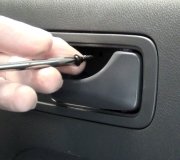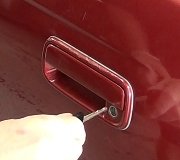Kvn4, you have a very one-sided opinion of car dealers. I worked for many years for a very nice family-owned Chrysler dealership, one of four dealerships they own, and you are exactly one hundred percent wrong on how they treat customers. They understand that a satisfied customer is a repeat customer. Very many people, including my ******, did not come in asking for "a salesman". They came in asking for Bill B. By name. He's been there since the 1980s and is always busy with someone in his office. We sold a lot of cars to people from out-of-town because we treated them well for a previous repair. You will get similar results from our local Buick / GMC dealer, Cadillac dealer, Toyota dealer, and the former Ford dealer. Only the Chevy dealer is disreputable and he, like GM in general, has a hard time finding repeat customers.
Tessab, you do not have to get angry with your dealer. Do you really think if they knew what the fix was, they would refuse to do it? Of course not. They want a happy customer as much as you want your car fixed. Of course they are under time constraints, just like doctors, plumbers, and accountants. To NOT have time limits would be an irresponsible way to run a business. Chrysler only allowed us one hour to diagnose an electrical problem. Normally that was plenty of time, but with all the ridiculous, unnecessary computers on cars now, some problems needed more time, and they always granted more time as long as you requested it first AND could show you were making progress. If you couldn't show that, they got other, more experienced mechanics, or their in-house troubleshooters involved to help out. They had a number of systems in place to insure their customers were satisfied. As far as customer-friendly manufacturers, General Motors, Volkswagen, and BMW are at the very bottom of the list. In my opinion, Hyundai is at the very top of the list, Toyota is next, and Chrysler is third. If Chrysler is so concerned with customer satisfaction, you can be certain Hyundai is too.
There's no harm in discussing a vehicle buyback, but the instant YOU get angry with the people who are trying to help, you make them an adversary instead of an advocate. They have absolutely nothing to gain by not fixing your car, or giving you that perceived "run-around". And when it comes to problems like this, there is no set time limit. Standard operations are listed in their labor guides. That's what kvn4 is referring to. As an example, a set time is given for replacing a water pump on a specific engine in a specific model. The time allowed might be listed at 3.0 hours for cars out-of-warranty but 2.6 hours for a car in warranty. Those in-warranty times assume all the needed tools are at hand, new parts are sitting nearby at the ready, and NO air tools are used. Out-of-warranty times provide allowances for rusty nuts and bolts, and less experience by the mechanic because he is working on different car brands and problems every day. Dealership mechanics see similar things every week and as a result, we get real good at meeting the designated times. Those times, in or out-of-warranty do not include the previous diagnosis time, the time the mechanic stands in line at the parts department to order the parts, the time he spends at the computer checking for service bulletins, etc. With in-warranty repairs, no one has to argue with a customer who is angry they have to pay for expensive parts and services. The dealer can just order the parts that are needed without worrying about the hit to the wallet of whoever is paying the bill. All the manufacturer is asking for is an accurate accounting of where that money is being spent and whether it is going to solve the problem.
With the type of problem you're having, the is absolutely no way anyone can calculate a "book time" to complete the repair. So to suggest the dealer isn't going to try to fix the car because they "already got paid for selling you the car" is ignorant at best. If this is a known problem with this model, you can be sure the manufacturer is working on a diagnosis and cure. That can lead to a voluntary recall, but not until the cure is found. If this is a one-of-a-kind problem that the manufacturer hasn't run into before, it's going to be real hard to diagnose the problem over the telephone.
The next thing to consider is politely asking for a meeting with the district representative. Most manufacturers have a system similar to Chrysler's. With them, the district rep. Visited each dealership once a month to check on the service department and to meet with customers who had problems the dealer couldn't help with. To keep a lid on expenses, something our ultra-rich politicians know nothing about, dealerships have a strict set of rules they have to follow. As with any other type of business, there are exceptions to every rule. The manufacturer's representative grants those exceptions, not the dealer. We had money provided by Chrysler to use at our discretion to pay for out-of-warranty repairs when the dealer felt that was the proper thing to do. Those funds were limited though, so they were reserved for regular repeat customers, hardship cases, and people who had more than their share of problems while their car was still in warranty. You can be sure that money wasn't wasted on angry customers. The feeling was you're going to be angry no matter what we do so you might as well pay the bill too. When the district rep. Gets involved, he has the authority to permit the dealer to do whatever is needed, and to reimburse their expenses. That has nothing to do with that out-of-warranty fund provided by the manufacturer.
To begin the process, the district rep. Is going to look at your car's repair history and the history of that model in general. He will have access to experts who can provide advice. He might even take your car to a different dealership for you. With GM, lemon law buybacks were simply donated to community colleges. They just gave up on them. As an instructor, I was involved with a few of them. With Chrysler, buybacks MUST be repaired, whatever the cost, then they go to an auto auction. As my dealer's only suspension and alignment specialist, I was involved with two trucks that both came from a different dealership that couldn't solve the problem. The district rep. Thought I was a genius after I fixed the first one, and a magician after I fixed the second one;... That is until I showed him the 32 page service bulletin I followed. Once I read that, the second truck took less than an hour, (and no parts), to fix. The original dealer couldn't fix the problem because they never looked for a service bulletin. And no one would EVER have solved the problem without that bulletin because the cause would not have had the same effect on older trucks. In fact, I worked with another fellow for three days on the first truck we had that problem with, (at 80,000 miles), and we accidentally identified the cause by just giving up and replacing random parts. THEN we looked for service bulletins, and there it was in black and white!
Remember that the dealer doesn't want you to have a problem with your car. They want to fix it so you'll be happy with their product. And all dealers understand that it takes more advertising dollars to get one new customer than it takes to keep ten current customers coming back. Why do you think GM has so many ads on tv? Making you dissatisfied is the equivalent to losing ten new customers.
The minute you get angry, or "mean", as kvn4 suggested, you just switched teams with the dealership. Now you'll be seen as the enemy and you can expect to be treated as such. You can be firm. You can "hold your ground". But you can do that in a cooperative manner. If you can't get help from a district representative, I'm sure there will be some type of resolution department you can contact. Their information is typically found in the owner's manual or possibly online. My dealer would even get the ball rolling by contacting them on your behalf if they thought you had a legitimate complaint.
When it comes to requesting a buyback, I never heard of anyone getting a lawyer involved. That doesn't mean it didn't happen. It just means that in my case, a lawyer wasn't needed to do what customers could do themselves. Lawyers, which are mostly members of one political party, make one person give money to another person, then take a huge cut for themselves. You shouldn't need to give up that cut. What you should be expecting though is you will not get the full price back for your car. As I recall, they will look at the miles and age of it and deduct an amount similar as if you had been renting or leasing it.
As an alternative, you might ask about trading it in on a different model. This is especially effective when the dealer says there's nothing wrong with the car. That happens mostly with road noise and wind noise. All cars are so extremely quiet compared to '70s and '80s models that we can hear little wisps of air flowing over windshield wipers and mirrors, and some people just can't put up with that. If the dealer says there's nothing wrong, or it's "the nature of the beast", it's going to be hard for them to change their tune when calculating how much to allow you for it on trade.
One last point to think about; if I understand correctly, you have water dripping from the ceiling. That is proof you do not have a water leak. Water doesn't run up. I've worked on plenty of cars that had water sloshing onto the floor from plugged air conditioning drain tubes. My own brand new '93 Dynasty had a severe water leak from the left rear door after I messed up the water shield after going nuts with rustproofing compound. We all know the horrendous problem Ford has with defective GEM computer modules from water leaking into them from windshield leaks. In all those cases, there has never once been any mention of water on the ceiling or anywhere else up high. To have water on the ceiling, you have to have a condensation problem. It's no wonder the dealer hasn't found a leak. There most likely isn't one.
Look at any car in the salvage yard that has the trunk open. You could raise fish in the pond in the trunk, yet there's no water on the ceiling. My first new car, an '80 Volare that I still own developed so much condensation on the inside of the windshield and all the other windows during the two-hour trip to college that I had to carry a rag with me to see where I was going. The harder I ran the defroster, the worse it got because I was blowing more humid air onto the cool glass. Still never had any condensation on the ceiling. My ****** had an almost identical '78 Lebaron, but it had air conditioning. After the windshield fogged up and you turned on the defroster, the AC turned on automatically and within five or ten seconds you could watch the fog disappear. THAT's why I suggested at the beginning to be sure the AC is running when defrost is selected.
Tuesday, January 31st, 2012 AT 5:25 AM





